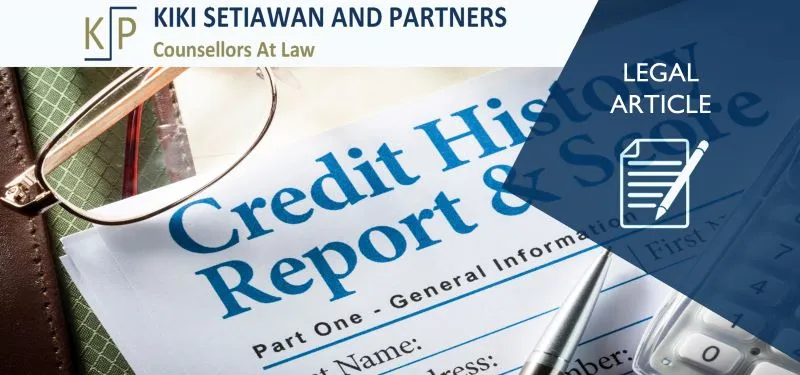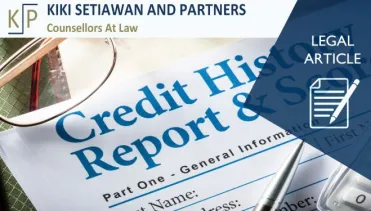
KSP LEGAL ARTICLES
Publication
KSP LEGAL ARTICLES
Getting To Know Types of Creditors in Civil and Bankruptcy Laws (Mengenal Jenis-Jenis Kreditor dalam Hukum Perdata dan Kepailitan)


Kiki Setiawan & Partners Law Office provides legal consultancy related to Civil, Criminal and Bankruptcy legal matters, please call us at
+62 21 2963 8070 or drop us an email at mail@ksplaw.co.id.
The Indonesian Civil Code (“ICC”) does not specifically use the terms creditor and debtor to explain the position of the parties in a debt receivable relationship. Article 1754 of the Civil Code defines the relationship as an act of borrowing and lending consumable goods, in this case money. On the other hand, Law No. 37 of 2004 concerning Bankruptcy and Suspension of Debt Payment Obligations (“Bankruptcy Law”) which was enacted later regulates the definition of Creditors and Debtors as regulated in Article 1 number 2 and Article 1 number 3 of the Bankruptcy Law.
Article 1 point 2
A creditor is a person who has a debt due to an agreement or law that can be collected in court.
Article 1 point 3
A debtor is a person who has debts due to agreements or laws whose repayments can be collected in court.
In general, creditors in civil law are divided into several types, namely concurrent, separatist, and preferred creditors. However, the names of such creditor types are not explicitly mentioned in the Indonesian Civil Code. In the context of bankruptcy, the Explanation of Article 2 paragraph (1) of the Bankruptcy Law also states that creditors in bankruptcy cases include concurrent, separatist, and preferred creditors. Each creditor has a different position in terms of obtaining debt repayment. The differences between the three creditors are as follows:
1. Concurrent Creditors
In the Indonesian Civil Code, concurrent creditors are implicitly mentioned in Article 1132 jo. 1131 which states that all goods belonging to the debtor become collateral for repayment against creditors, unless among the creditors there are valid reasons for priority among creditors. Basically, concurrent creditors are creditors who are not privileged over other creditors because they do not have collateral or are not also given a privilege right by law. In simple terms, these creditors are ordinary creditors whose repayment rights are not privileged from others.
Bankruptcy law stipulates that all of the debtor's assets will be used for repayment. Concurrent creditors in bankruptcy also have the same definition, namely ordinary creditors who do not have collateral or are not privileged by law. Examples of concurrent creditors are creditors of debt agreements that are not accompanied by security or collateral rights (such as fintech lending, personal loans), or counterparties to business transactions that have not been repaid.
2. Separatist Creditor
Based on Article 1133 jo. 1134 of the Indonesian Civil Code, a separatist creditor is a creditor who are privileged in which the right is arising from certain collateral, namely pledge, mortgage, fiduciary, or other collateral rights. These creditors have the right to debt repayment from the debtor's collateral, where the creditor has the right to sell the collateral to obtain repayment.
In the context of bankruptcy, separatist creditors are regulated in Article 55 paragraph (1) of the Bankruptcy Law. This article gives creditors holding pledge, fiduciary, mortgage, or other collateral rights the right to execute these collateral rights to obtain repayment. Examples of separatist creditors include banks that hold collateral rights.
3. Preferred Creditors
In Article 1134 of the Indonesian Civil Code, it is stated that preferred creditors are creditors who are privileged because the law gives special rights to their credits. The types are regulated in Article 1139 jo. 1149 of the Indonesian Civil Code. Seemingly, the position of preferred creditors in Article 1134 of the Indonesian Civil Code is lower than that of separatist creditors, unless otherwise expressly provided by law.
In the Bankruptcy Law, preferred creditors are regulated in Article 21 paragraph (1) and paragraph (3) which consists of state tax debts and court costs. In addition, based on Constitutional Court Decision No. 67/PUU-XI/2013, there are other expressly preferred creditors that must be privileged over other creditors, namely the unpaid wages of workers/laborers. Of course, these creditors are given a higher right to repayment than all other creditors.
Position of Creditors in Bankruptcy
Based on the previous explanation, it can be concluded that the position of creditors in bankruptcy can be sorted as follows:
1. Preferred creditors who are prioritized such as basic wages of workers/laborers, state taxes and court costs;
2. Separatist creditors such as holders of collateral, excluding corporate guarantee holders; and
3. Concurrent creditors include companies or individuals who have debts due to business activities with the debtor.
As a creditor in the very last position, the settlement portion of concurrent creditors in the event of bankruptcy can only be fulfilled when the portion of the creditors above them has been given. In addition, there are also several differences in the rights between these creditors in terms of voting in the Bankruptcy Law, namely:
1. Voting for the replacement of the Curator and the Creditors' committee, can only be conducted by concurrent creditors (Article 71 and Article 80 of the Bankruptcy Law).
2. Voting for peace plan in bankruptcy, may not be conducted by separatist or preferred creditors, unless they waive their right of precedence (Article 149 of the Bankruptcy Law).
3. Voting for permanent PKPU and its extension approval, only by concurrent creditors and separatist creditors (Article 229 paragraph [1] of the Bankruptcy Law).
4. Voting for peace plan in Suspension of Debt Payment Obligations, only by concurrent creditors and separatist creditors (Article 281 paragraph [1] of the Bankruptcy Law).
Click DOWNLOAD PDF to read the Indonesian version of this Article
+62 21 2963 8070 or drop us an email at mail@ksplaw.co.id.
The Indonesian Civil Code (“ICC”) does not specifically use the terms creditor and debtor to explain the position of the parties in a debt receivable relationship. Article 1754 of the Civil Code defines the relationship as an act of borrowing and lending consumable goods, in this case money. On the other hand, Law No. 37 of 2004 concerning Bankruptcy and Suspension of Debt Payment Obligations (“Bankruptcy Law”) which was enacted later regulates the definition of Creditors and Debtors as regulated in Article 1 number 2 and Article 1 number 3 of the Bankruptcy Law.
Article 1 point 2
A creditor is a person who has a debt due to an agreement or law that can be collected in court.
Article 1 point 3
A debtor is a person who has debts due to agreements or laws whose repayments can be collected in court.
In general, creditors in civil law are divided into several types, namely concurrent, separatist, and preferred creditors. However, the names of such creditor types are not explicitly mentioned in the Indonesian Civil Code. In the context of bankruptcy, the Explanation of Article 2 paragraph (1) of the Bankruptcy Law also states that creditors in bankruptcy cases include concurrent, separatist, and preferred creditors. Each creditor has a different position in terms of obtaining debt repayment. The differences between the three creditors are as follows:
1. Concurrent Creditors
In the Indonesian Civil Code, concurrent creditors are implicitly mentioned in Article 1132 jo. 1131 which states that all goods belonging to the debtor become collateral for repayment against creditors, unless among the creditors there are valid reasons for priority among creditors. Basically, concurrent creditors are creditors who are not privileged over other creditors because they do not have collateral or are not also given a privilege right by law. In simple terms, these creditors are ordinary creditors whose repayment rights are not privileged from others.
Bankruptcy law stipulates that all of the debtor's assets will be used for repayment. Concurrent creditors in bankruptcy also have the same definition, namely ordinary creditors who do not have collateral or are not privileged by law. Examples of concurrent creditors are creditors of debt agreements that are not accompanied by security or collateral rights (such as fintech lending, personal loans), or counterparties to business transactions that have not been repaid.
2. Separatist Creditor
Based on Article 1133 jo. 1134 of the Indonesian Civil Code, a separatist creditor is a creditor who are privileged in which the right is arising from certain collateral, namely pledge, mortgage, fiduciary, or other collateral rights. These creditors have the right to debt repayment from the debtor's collateral, where the creditor has the right to sell the collateral to obtain repayment.
In the context of bankruptcy, separatist creditors are regulated in Article 55 paragraph (1) of the Bankruptcy Law. This article gives creditors holding pledge, fiduciary, mortgage, or other collateral rights the right to execute these collateral rights to obtain repayment. Examples of separatist creditors include banks that hold collateral rights.
3. Preferred Creditors
In Article 1134 of the Indonesian Civil Code, it is stated that preferred creditors are creditors who are privileged because the law gives special rights to their credits. The types are regulated in Article 1139 jo. 1149 of the Indonesian Civil Code. Seemingly, the position of preferred creditors in Article 1134 of the Indonesian Civil Code is lower than that of separatist creditors, unless otherwise expressly provided by law.
In the Bankruptcy Law, preferred creditors are regulated in Article 21 paragraph (1) and paragraph (3) which consists of state tax debts and court costs. In addition, based on Constitutional Court Decision No. 67/PUU-XI/2013, there are other expressly preferred creditors that must be privileged over other creditors, namely the unpaid wages of workers/laborers. Of course, these creditors are given a higher right to repayment than all other creditors.
Position of Creditors in Bankruptcy
Based on the previous explanation, it can be concluded that the position of creditors in bankruptcy can be sorted as follows:
1. Preferred creditors who are prioritized such as basic wages of workers/laborers, state taxes and court costs;
2. Separatist creditors such as holders of collateral, excluding corporate guarantee holders; and
3. Concurrent creditors include companies or individuals who have debts due to business activities with the debtor.
As a creditor in the very last position, the settlement portion of concurrent creditors in the event of bankruptcy can only be fulfilled when the portion of the creditors above them has been given. In addition, there are also several differences in the rights between these creditors in terms of voting in the Bankruptcy Law, namely:
1. Voting for the replacement of the Curator and the Creditors' committee, can only be conducted by concurrent creditors (Article 71 and Article 80 of the Bankruptcy Law).
2. Voting for peace plan in bankruptcy, may not be conducted by separatist or preferred creditors, unless they waive their right of precedence (Article 149 of the Bankruptcy Law).
3. Voting for permanent PKPU and its extension approval, only by concurrent creditors and separatist creditors (Article 229 paragraph [1] of the Bankruptcy Law).
4. Voting for peace plan in Suspension of Debt Payment Obligations, only by concurrent creditors and separatist creditors (Article 281 paragraph [1] of the Bankruptcy Law).
Click DOWNLOAD PDF to read the Indonesian version of this Article

Latest KSP LEGAL ARTICLES





